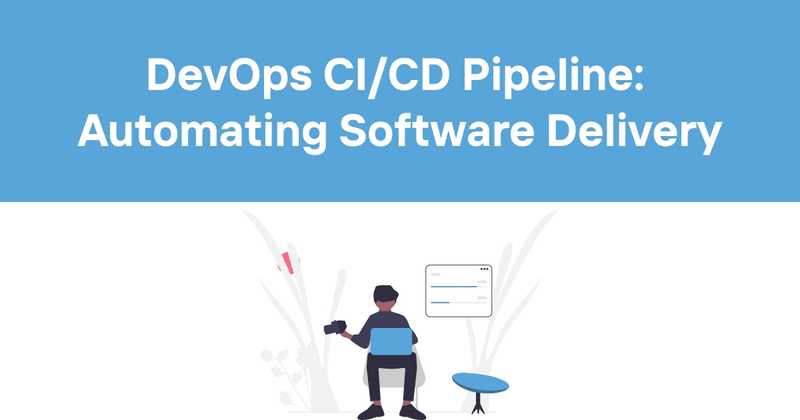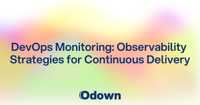DevOps CI/CD Pipeline: Automating Software Delivery
DevOps and CI/CD are two closely related practices that have revolutionized how software is developed and delivered. While often mentioned together, they serve distinct yet complementary purposes in the software development lifecycle. This article will explore DevOps and CI/CD in depth, examining how they work together to enable faster, more reliable software delivery.
Table of Contents
- What is DevOps?
- Understanding CI/CD
- Key Differences Between DevOps and CI/CD
- How DevOps and CI/CD Work Together
- Benefits of Integrating DevOps and CI/CD
- Challenges in Implementation
- Best Practices for DevOps and CI/CD
- Tools for DevOps and CI/CD
- The Role of Feature Flags
- Real-World Examples
- Future Trends
- Conclusion
What is DevOps?
DevOps is a cultural and organizational approach that aims to break down silos between development and operations teams. It's about fostering collaboration, communication, and shared responsibility throughout the entire software development lifecycle.
At its core, DevOps is about:
- Collaboration: Bringing developers and operations staff together
- Automation: Streamlining repetitive tasks
- Continuous improvement: Always looking for ways to enhance processes
- Faster delivery: Reducing time-to-market for new features
- Reliability: Ensuring stable and secure systems
DevOps isn't just a set of tools or practices - it's a mindset shift. It requires teams to rethink how they work together and approach software development holistically.
I've seen firsthand how DevOps can transform organizations. In one company I worked with, implementing DevOps principles reduced deployment times from weeks to hours. The key was getting developers and ops teams to collaborate closely from the start, rather than throwing code "over the wall."
Understanding CI/CD
While DevOps is a broad philosophy, CI/CD refers to specific practices within the software delivery process:
Continuous Integration (CI) is the practice of frequently merging code changes into a shared repository. Each integration triggers automated builds and tests to catch issues early.
CI aims to:
- Detect integration problems quickly
- Improve software quality
- Reduce time spent debugging
Continuous Delivery (CD) takes CI a step further. It automates the entire software release process, making it possible to deploy code changes to production at any time.
CD involves:
- Automatically building, testing, and preparing code for release
- Deploying to staging environments
- Enabling one-click deployments to production
Some organizations take CD even further with Continuous Deployment, where every change that passes automated tests is automatically deployed to production.
Here's a quick comparison:
| Practice | Focus | Goal |
|---|---|---|
| CI | Code integration | Catch issues early |
| CD | Release automation | Enable rapid, reliable deployments |
| Continuous Deployment | Automated production releases | Deliver changes to users quickly |
CI/CD pipelines are the backbone of modern software delivery. They provide a consistent, automated way to build, test, and deploy code changes.
Key Differences Between DevOps and CI/CD
While DevOps and CI/CD are closely related, they have some key differences:
-
Scope
- DevOps: Broad cultural and organizational approach
- CI/CD: Specific set of practices focused on automating software delivery
-
Focus
- DevOps: Collaboration between development and operations
- CI/CD: Automating integration, testing, and deployment processes
-
Implementation
- DevOps: Requires organizational change and cultural shift
- CI/CD: Involves setting up tools and automation pipelines
-
Outcome
- DevOps: Improved collaboration, faster delivery, better quality
- CI/CD: Faster, more frequent, and more reliable software releases
-
Tools
- DevOps: Wide range of tools for collaboration, monitoring, and automation
- CI/CD: Specific tools for build automation, testing, and deployment
It's worth noting that while you can implement CI/CD without fully embracing DevOps, the two practices are most effective when used together.
How DevOps and CI/CD Work Together
DevOps and CI/CD are highly complementary. DevOps provides the cultural foundation and collaborative mindset, while CI/CD offers the practical tools and processes to automate software delivery.
Here's how they typically work together:
- DevOps culture encourages closer collaboration between dev and ops teams.
- This collaboration leads to better alignment on goals and processes.
- Teams implement CI/CD pipelines to automate integration, testing, and deployment.
- Automated pipelines enable faster, more frequent releases.
- Faster releases allow for quicker feedback and iteration.
- The cycle continues, with teams continuously improving their processes.
The result? A virtuous cycle of faster delivery, higher quality, and improved collaboration.
I once worked on a project where we struggled with long, painful release cycles. Introducing CI/CD within a DevOps framework was a game-changer. Not only did we speed up releases, but the improved collaboration between dev and ops meant fewer surprises and smoother deployments.
Benefits of Integrating DevOps and CI/CD
Combining DevOps and CI/CD can lead to significant improvements in software delivery:
-
Faster time-to-market: Automated pipelines and improved collaboration speed up the entire development process.
-
Improved software quality: Frequent integration and automated testing catch bugs earlier.
-
Increased productivity: Automation frees up developers to focus on writing code rather than manual tasks.
-
Better collaboration: DevOps breaks down silos, leading to improved communication and shared goals.
-
More reliable releases: Consistent, automated processes reduce the risk of human error during deployments.
-
Faster feedback loops: Frequent releases allow teams to gather user feedback more quickly.
-
Improved customer satisfaction: Faster delivery of features and bug fixes leads to happier users.
-
Reduced costs: Automation and improved efficiency can lead to significant cost savings over time.
-
Better scalability: CI/CD pipelines make it easier to manage complex projects and handle growth.
-
Increased innovation: Faster delivery and reduced risk enable teams to experiment more freely.
Challenges in Implementation
While the benefits are clear, implementing DevOps and CI/CD isn't without its challenges:
-
Cultural resistance: Shifting to a DevOps mindset can be difficult for organizations with entrenched silos.
-
Technical complexity: Setting up robust CI/CD pipelines requires significant technical expertise.
-
Initial investment: There's often a substantial upfront cost in terms of time and resources.
-
Security concerns: Automated deployments can raise security issues if not properly managed.
-
Legacy systems: Older systems may not be easily integrated into modern CI/CD pipelines.
-
Skill gaps: Teams may need to upskill to work effectively in a DevOps environment.
-
Tool overload: With so many DevOps and CI/CD tools available, choosing the right ones can be overwhelming.
-
Maintaining velocity: As projects grow, maintaining fast build and deployment times can become challenging.
-
Balancing speed and quality: There's a risk of prioritizing speed over code quality and thorough testing.
-
Measuring success: Defining and tracking meaningful metrics for DevOps and CI/CD can be difficult.
Overcoming these challenges requires commitment, planning, and often a gradual approach to implementation.
Best Practices for DevOps and CI/CD
To maximize the benefits of DevOps and CI/CD, consider these best practices:
-
Start small: Begin with a pilot project to test your processes before scaling.
-
Automate everything: From testing to deployment, automate as much as possible.
-
Use version control: Keep all code, including infrastructure configurations, in version control.
-
Implement trunk-based development: Work in small batches and merge frequently to the main branch.
-
Prioritize testing: Invest in comprehensive automated testing at all levels (unit, integration, end-to-end).
-
Monitor and measure: Use metrics to track performance and identify areas for improvement.
-
Embrace infrastructure as code: Manage infrastructure through code for consistency and version control.
-
Implement continuous security: Integrate security checks throughout the pipeline, not just at the end.
-
Foster a learning culture: Encourage experimentation and learning from failures.
-
Use feature flags: Decouple deployment from release to enable safer, more controlled rollouts.
-
Standardize environments: Ensure consistency across development, testing, and production environments.
-
Practice chaos engineering: Regularly test system resilience by intentionally introducing failures.
-
Implement blue-green deployments: Use parallel environments to enable seamless rollbacks if issues arise.
-
Prioritize observability: Implement robust logging, monitoring, and tracing to quickly identify and resolve issues.
-
Continuously optimize: Regularly review and refine your processes and tooling.
Remember, these practices should be adapted to your specific context. What works for one team may not work for another.
Tools for DevOps and CI/CD
There's a wide array of tools available to support DevOps and CI/CD practices. Here are some popular options:
-
Version Control:
- Git
- GitHub
- GitLab
- Bitbucket
-
CI/CD Platforms:
- Jenkins
- GitLab CI
- CircleCI
- Travis CI
- Azure DevOps
-
Configuration Management:
- Ansible
- Puppet
- Chef
-
Containerization:
- Docker
- Kubernetes
-
Infrastructure as Code:
- Terraform
- CloudFormation
-
Monitoring and Logging:
- Prometheus
- Grafana
- ELK Stack (Elasticsearch, Logstash, Kibana)
-
Collaboration:
- Slack
- Microsoft Teams
- Jira
-
Testing:
- Selenium
- JUnit
- Jest
-
Artifact Repositories:
- Nexus
- Artifactory
-
Feature Flag Management:
- LaunchDarkly
- Optimizely
The key is to choose tools that integrate well with your existing stack and meet your specific needs. Don't fall into the trap of tool sprawl - focus on a core set of tools that work well together.
The Role of Feature Flags
Feature flags (also known as feature toggles) play a crucial role in modern DevOps and CI/CD practices. They allow teams to decouple deployment from release, providing greater control and reducing risk.
With feature flags, you can:
- Deploy code to production without immediately exposing new features
- Gradually roll out features to specific user segments
- A/B test different versions of a feature
- Quickly disable problematic features without a full rollback
Feature flags enable a practice known as "progressive delivery," where new features are gradually exposed to users. This approach reduces risk and allows for faster feedback cycles.
I've found feature flags invaluable for managing complex releases. In one project, we used them to slowly roll out a major UI redesign, gathering feedback and making adjustments along the way. It allowed us to be much more agile in our approach to big changes.
Real-World Examples
Let's look at some real-world examples of how companies have successfully implemented DevOps and CI/CD:
-
Amazon:
- Deploys code every 11.7 seconds on average
- Uses microservices architecture and continuous deployment
- Reduced deployment times from hours to seconds
-
Netflix:
- Deploys hundreds of times per day
- Uses chaos engineering to test system resilience
- Developed tools like Spinnaker for cloud-based continuous delivery
-
Etsy:
- Moved from bi-monthly releases to 50+ deploys per day
- Emphasizes small, frequent changes over large releases
- Uses feature flags extensively for controlled rollouts
-
Google:
- Manages a monolithic codebase with rapid release cycles
- Uses an internal tool called Rapid for continuous integration
- Emphasizes automated testing, with millions of tests run daily
-
Spotify:
- Uses "squads" and "tribes" to organize DevOps teams
- Implements CI/CD for both backend and mobile app development
- Developed "Backstage," an open-source developer portal platform
These companies demonstrate how DevOps and CI/CD can be scaled to handle even the most complex and high-traffic systems.
Future Trends
As DevOps and CI/CD continue to evolve, several trends are emerging:
-
AI/ML in DevOps: Machine learning is being used to optimize CI/CD pipelines and predict potential issues.
-
GitOps: Using Git as a single source of truth for declarative infrastructure and applications.
-
DevSecOps: Integrating security practices throughout the development lifecycle.
-
Serverless CI/CD: Using serverless computing to run CI/CD pipelines more efficiently.
-
Kubernetes-native CI/CD: Tools and practices specifically designed for Kubernetes environments.
-
Low-code/No-code DevOps: Making DevOps practices more accessible to non-technical team members.
-
Edge computing in CI/CD: Adapting CI/CD practices for edge computing environments.
-
Green DevOps: Focusing on environmental sustainability in software development and operations.
-
AIOps: Using AI for IT operations, including anomaly detection and automated issue resolution.
-
DevOps for IoT: Adapting DevOps practices for Internet of Things (IoT) development.
These trends point towards even greater automation, integration, and intelligence in software delivery processes.
Conclusion
DevOps and CI/CD have transformed the landscape of software development and delivery. By breaking down silos, automating processes, and fostering a culture of continuous improvement, organizations can deliver software faster, more reliably, and with higher quality.
While implementing these practices comes with challenges, the benefits in terms of productivity, quality, and innovation are substantial. As the field continues to evolve, staying up-to-date with best practices and emerging trends will be crucial for teams looking to maintain a competitive edge.
For those looking to improve their DevOps and CI/CD practices, tools like Odown can play a crucial role. Odown provides website and API monitoring, helping teams catch and resolve issues quickly. Its public status pages improve transparency and communication during incidents, a key aspect of DevOps culture. Additionally, Odown's SSL certificate monitoring ensures that security remains a priority throughout the development and operation process.
By leveraging tools like Odown alongside robust DevOps and CI/CD practices, teams can create a powerful framework for delivering high-quality software at speed. The future of software delivery is continuous, collaborative, and increasingly automated - and DevOps and CI/CD are at the heart of this transformation.



